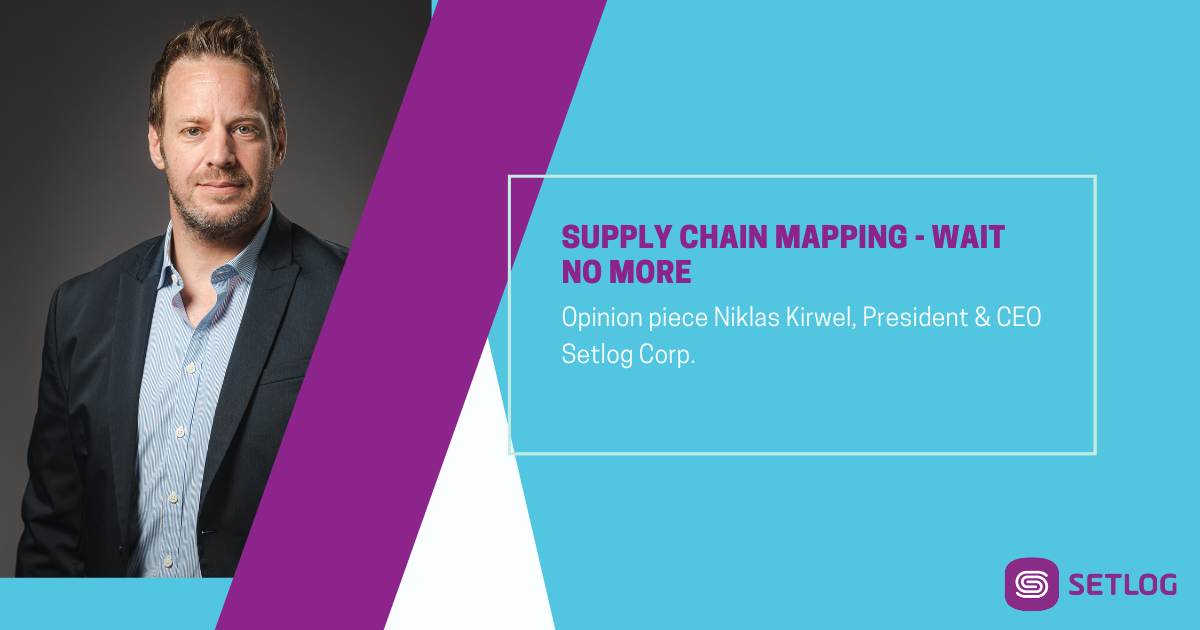This statement is written by
Niklas Kirwel, President & CEO of Setlog Corp. since 01.07.2021. For more than 15 years, he has been an expert in project and product management as well as in consulting and sales of technology projects in the consumer goods and apparel industry.
August, 2022
I just came back from a 3-day conference in Pittsburgh organized by the American Apparel & Footwear Association (AAFA). It was great to see so many old and new faces, connecting and getting back together in person. The overall theme of the event was supply chain traceability, social and environmental compliance, and sustainability.

Today’s consumers want to know where and how (read: it better be under fair and environmentally sustainable conditions) their products were made, and brands and retailers are trying hard to tell them. The prerequisite for their success though is end-to end visibility into their supply chains.
Tier-levels
Most companies have complete records only for their tier 1 suppliers – their partners who receive their purchase orders. The challenge for responsible sourcing teams however is the lack of visibility into what is known as ‘tier n’ – factories, processing facilities and material-level suppliers that make up the foundation of the upstream supply chain. Just envision a snowboard jacket made of 50 different components from different raw material suppliers.
Mapping these lower tier-level supply chain partners is a challenge, but if you want to give consumers the requested transparency there is no alternative.
And then, there’s local and global legislation
In January 2022, the New York State Assembly unveiled the Fashion Sustainability and Social Accountability Act. It did not advance out of committee this session, but is currently being improved so that the bill passes in 2023. If passed, it would make New York the first state to pass legislation holding the biggest fashion brands to account for their role in climate change. As per the current language, the law would apply to global apparel and footwear companies with more than US$100mn in revenue that conduct business in New York ‒ which certainly covers pretty much every large international fashion brand.
The NY Fashion Act will require such companies to map their supply chain and publicly disclose information about their greenhouse gas footprint, social and environmental initiatives, working conditions in their supply chains as well as report about recycling, water, and chemical management.
Assembly sponsor Anna Kelles, a Democrat from Ithaca, highlights that the impact, even though a New York bill, would certainly be global and affect all suppliers of companies covered by the bill.
On the federal level – since the end of June – US Customs and Border Protection (CBP) has started to enforce the Uyghur Forced Labor Protection Act (UFLPA), banning all imports into the US from Xinjiang Province in China, a region that is responsible for roughly 20% of the world’s cotton supply.
The law enforces the rebuttable presumption that all goods with a nexus to Xinjiang are made with forced labor, forcing the importer to prove a negative. The importer needs to substantiate that inputs are sourced completely from outside Xinjiang or, although goods may be covered by the UFLPA, an exception applies because there was no forced labor.
Penalties for UFLPA violations are high, involving civil or criminal penalties, or both. Not only will impacted goods be seized at the border, but the resulting disruption and reputational damage is likely to be severe, and lasting.
Similar laws across Europe such as the German Supply Chain Due Diligence Act or the Norwegian Transparency Act have set out to eliminate unethical labor practices from the supply chain. The EU itself is working on a directive on Corporate Sustainability Due Diligence.
It is just a matter of time
I believe it is just a matter of time before further federal, or state legislation – both in the US and in Europe – requires brands and retailers to step up their game and publicly submit detailed reports on the implementation of a due diligence framework and their continuous reduction of negative risks.
The benefits of supply chain mapping, however, go well beyond information availability and mitigating regulatory and reputational risks. Disruptions in global supply chains jeopardize the financial sustainability of companies.
In the aftermath of Covid-19, businesses have identified challenges and weak points in their supply chains, among them supply, material and labor shortages, congested ports, container space limitations, transport delays and surging prices due to inflation. These problems go far beyond tier 1 and can only be addressed holistically.
Don’t focus on what you can’t do but start somewhere
From my point of view, there is no way to further delay mapping, traceability, and transparency in your supply chain. It is no longer a ‘nice-to-have’ that companies can afford to go without, but critical to meet regulatory and consumer requirements as well as business needs in a competitive environment.
In his book ‘Post Corona’ Scott Galloway, professor of Marketing at NYU, says “Industries become ripe for disruption when existing players fail to adopt technological change to improve quality and value, as it may threaten their core business.”
I am positive that companies with digitized and traceable supply chains already outrun their competitors with limited visibility.
Digitization is key to accurate supply chain mapping beyond tier 1. Modern supply chain management software solutions open a whole new world of collaboration with your partners and provide you with a single point of access for everything related to responsible sourcing. Digital supply chain mapping is the foundation for traceability, social and environmental compliance.
Or, as one of the presenters at the AAFA conference in Pittsburgh put it:” Nothing is not digital now”.
